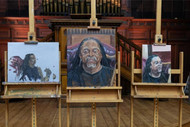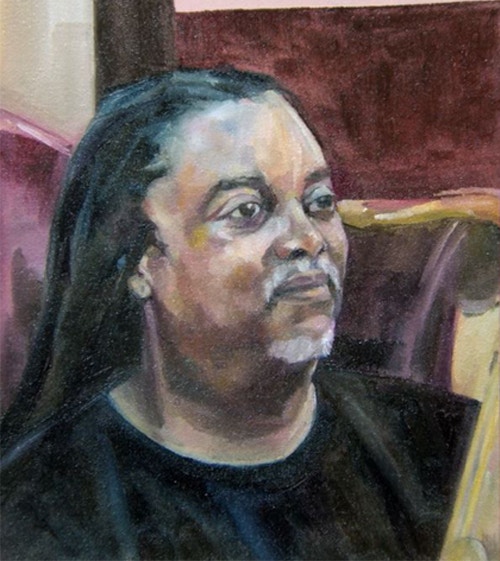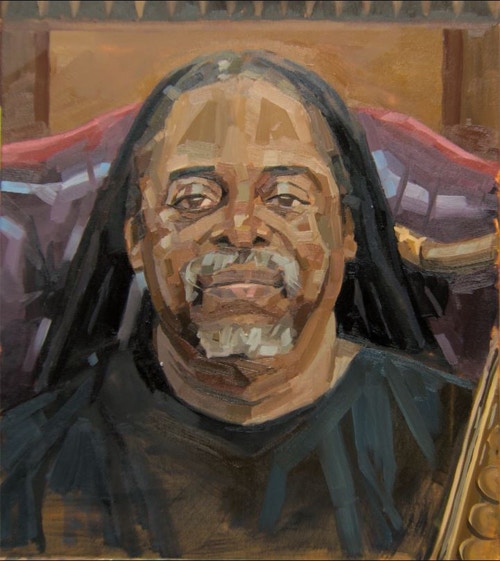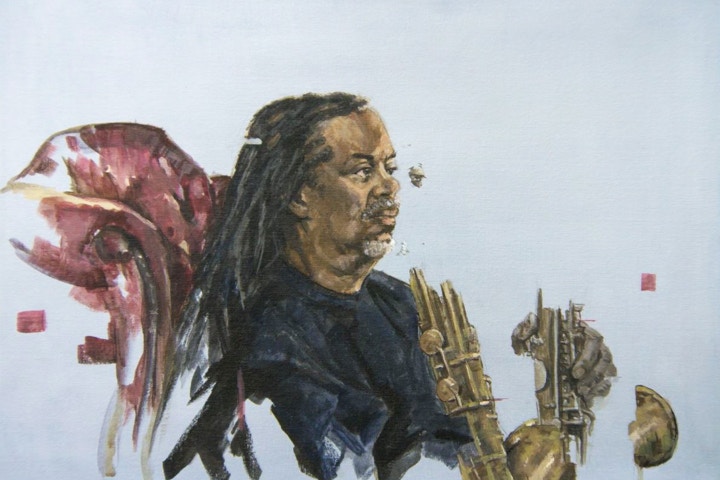Exclusive Interview: Sky Arts Portrait Artist of the Year 2019, meet the finalists
Posted by Cass Art on 9th Apr 2019
After weeks of wonderful paintings, tight decisions and nail biting moments the three semi-finalist winners are on their way to the finals of Sky Arts Portrait Artist of the Year 2019. The judges added a new dimension to the task of painting world renowned jazz musician Courtney Pine – the painters had to not simply capture the likeness of Courtney, but capture the essence of his music too. The contestants were spurred onto the challenge by a wonderful impromptu saxophone performance from the man himself.
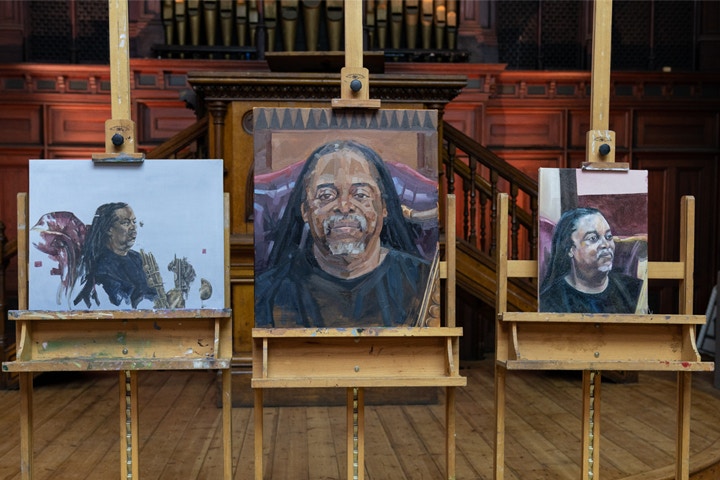
The three winners paintings: Left to Right, Tom Mead, Duncan Shoosmith and Sara Lavelle
We caught up with the three finalists to delve into their experience of the semi- final:
Firstly, congratulations to all of you on reaching the finals of Sky Arts Portrait Artist of the Year 2019! How did you find the semi-finals, the brief added another dynamic with the consideration of reflecting music and the sitter – was this added layer a challenge?
SARA
Thank you! The semi-finals were incredibly tough. It was a fantastic experience to be painting alongside such amazing artists in such a beautiful space. All the artists helped each other out on the day and I learned so much from them all.
The added brief was definitely a challenge. I wanted to make sure that I fulfilled the brief without the painting being gimmicky or naff. For me, the emotional mood or tone of a painting is the most important part. Courtney’s music is integral to who he is. I hoped that by painting him faithfully and authentically then that would come through and the painting would reflect his music naturally.
DUNCAN
I was thrilled to reach the semi-finals but assumed that that was a far as I would go in the competition having said that, I found the added pressure really focused my mind. I wanted to achieve more of a likeness than I had in the Heat, so just took a little more time than I normally do in the early stages.
The brief was to reflect a musical link to the sitter. I tend to paint heads reasonably large 11 or 12 inches upwards and I tighten up if I paint much smaller than this so to paint the head to my normal scale and also include the whole saxophone would’ve required a pretty large canvas and I was working with a 20 x 24. So I focused on Courtney, after all this was a portrait of him, not his sax and included the neck and section of the sax that fell within my composition and was helped out by the fact that towering over him was an enormous church organ the line of pipes just seemed too good to ignore, and they also brought a regal edge to the painting particularly with Courtney sitting in a throne-like chair.
On the day there were timing issues which meant that we took lunch early, before starting our paintings most people didn’t then leave their easels till the “4 hours” was up, such was the pressure in the room no breaks, no sustenance at the end I was completely shot.
TOM
Thank you! I liked the idea of an added narrative to the painting, but mixing that with another four hour time limit was quite daunting. Thankfully Courtney brought his saxophone along and that gave me something to play with, deconstructing the instrument and the rest of the image seemed to add a sort of jazz-like aesthetic too.
Sara Lavelle, Courtney Pine
SARA LAVELLE
You’re a big fan of jazz, and were listening to Courtney’s music while you painted – did it help you channel his character through your hand?
I believe so. Courtney is loud character. He came into the hall and immediately played his saxophone for us. He is almost inseparable from the music he makes. It felt wrong to be painting him in a quiet room without these sounds.
Sketching is a big part of your work; you draw with a variety of materials, from pencil to pastel. How does sketching and drawing sit with/alongside your painting practice?
My drawing practice is fundamental to my painting practice. Drawing is the most immediate way to record observation. I draw constantly, not to train my hand but to train my eyes. The more I learn to see, the better my art will be.
When I paint someones face, I break it down into a collection of coloured parts. Using oil paints, there is an infinite palette that I can mix so I have a tendency to become too particular and concerned with naturalism. I want to push my work further into abstraction which is possible through pushing my use of colour. I have explored this through limiting my palette by using oil pastels or colouring pencils. If I see a hint of blue in the shadow below the eye, I have no choice but to draw this using a bright blue oil pastel rather than mix something more subtle. This practice has been brilliant for my work.
And finally, what’s coming up next for you and your work?
Having finished my university degree, I am working as a full-time painter in London. I am enjoying moving between commission based work and self-initiated projects. I am working towards a number of shows, both group and solo, including the Royal Society of Portrait Painters Annual Exhibition held at the Mall Galleries in May.
See more of Sara's work by visiting her website, and following her on instagram
Duncan Shoosmith, Courtney Pine
DUNCAN SHOOSMITH
The face is such a presence in your portrait; Courtney is truly front and centre with a powerful gaze. You often paint your portraits in this way, your submission self-portrait an example of this – could you talk about your compositional choices when you approach a portrait?
Courtney is a big bloke and I would’ve loved to have gone extra-large with the head big, bold strokes to form a large, solid, lump of a head. I think you respond to the situation and I had to hold back a bit to allow for other aspects of the painting. Composition can be tricky if you’re only dealing with the head then things are a bit easier…if the head is fairly tightly cropped as in my SP then the painting will hold together. On another occasion it would’ve be great to get a sense of Courtney’s height and bulk but in the competition you’re working off a 3 hour timescale (after interruptions etc) so the composition ends up being a compromise. Generally when I work out the composition of a portrait I’m trying to let the sitter dictate unconsciously, something they do, some odd way they sit, maybe a particularly angle of their head that is a bit different, a bit quirky without being pretentious. I want a composition that interests me, it’s a balance and you have to judge how far you think you can push the client.
And finally, what’s coming up next for you and your work?
I’ve got a stack of paintings on the go at the moment, some commissions and some off own back. I’m trying to push myself and keep the momentum from the competition going. Enjoying getting bigger and bolder painting friends, people I’ve known for years, people that you can play around with the composition with, people where there is no pressure on the result, the opposite of the show!
See more of Duncan's work by visiting his website and following him on Instagram
Tom Mead, Courtney Pine
TOM MEAD
The judges compared your approach to the saxophone as cubist in nature; is a connection with art history important to you?
If I’m ever struggling for ideas with my work, I always find it’s best to look at historical paintings. Cubism definitely set rules about abstracting and fracturing subjects into geometric shapes, which I always try to keep in mind. Apparently nothing in Art is original anymore, so I might as well make the most of what has come before! I also find with my studio work, that taking inspiration from history but using contemporary scenes and sitters can be very effective.
How did it feel when Courtney selected your work to take home?
I was so so happy actually. I found the semi-final quite intense and felt drained after we finished, so to be instantly rewarded with some really kind words from the sitter meant a lot. I also thought the standard of paintings from the other semi-finalists was very high, so to be chosen was especially motivating.
And finally, what’s coming up next for you and your work?
I’m graduating from my degree very soon, and I hope to start taking more commissions and being able to call myself a professional artist straight after, which the show has given me a fantastic foundation for. I’ve definitely started making my work with a lot more confidence since filming the show, and my paintings have become more professional for it. Hopefully whatever project I do next will be a bit more relaxing than being on TV.
See more of Tom's work by visiting his website and following him on Instagram
